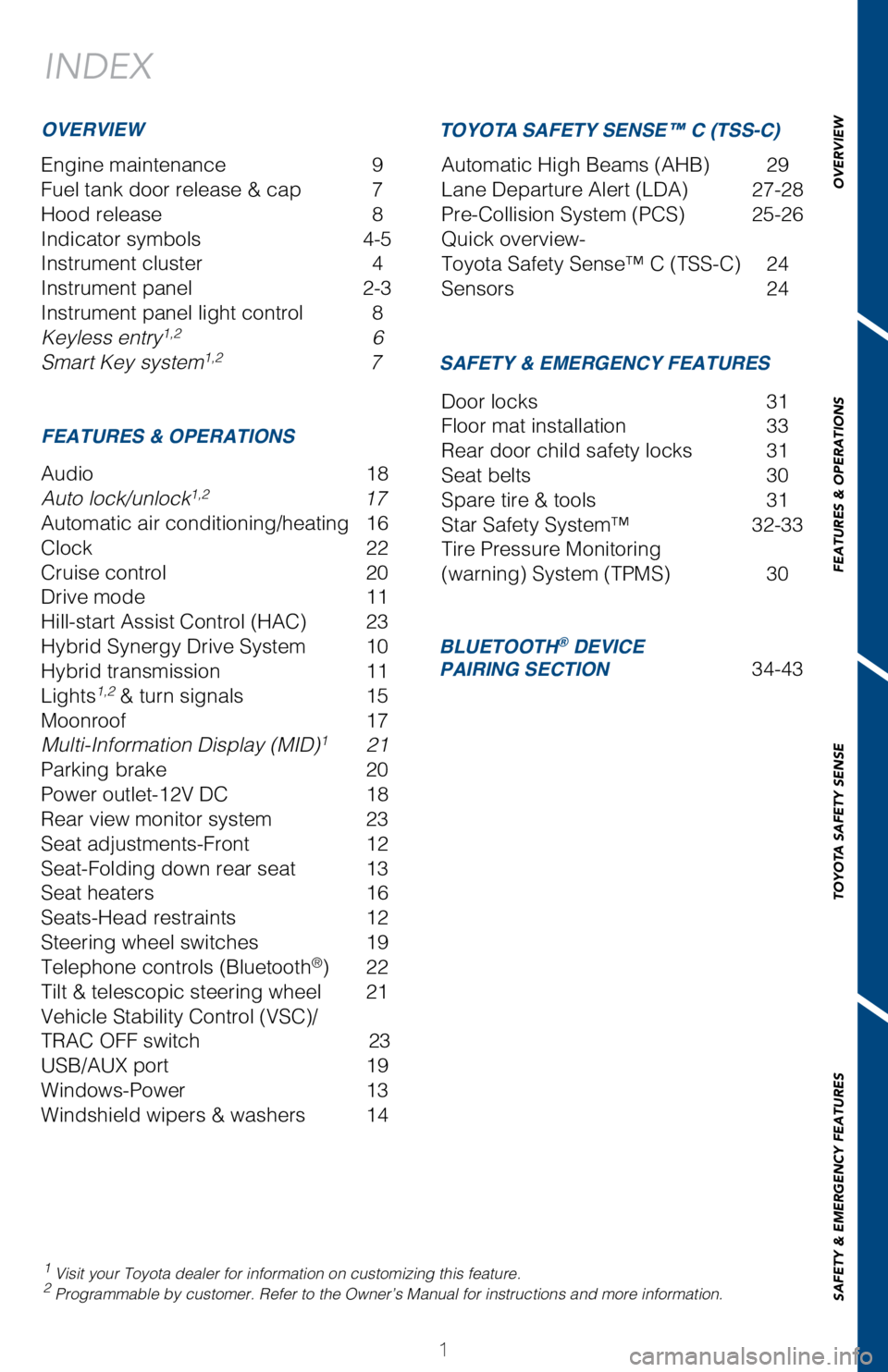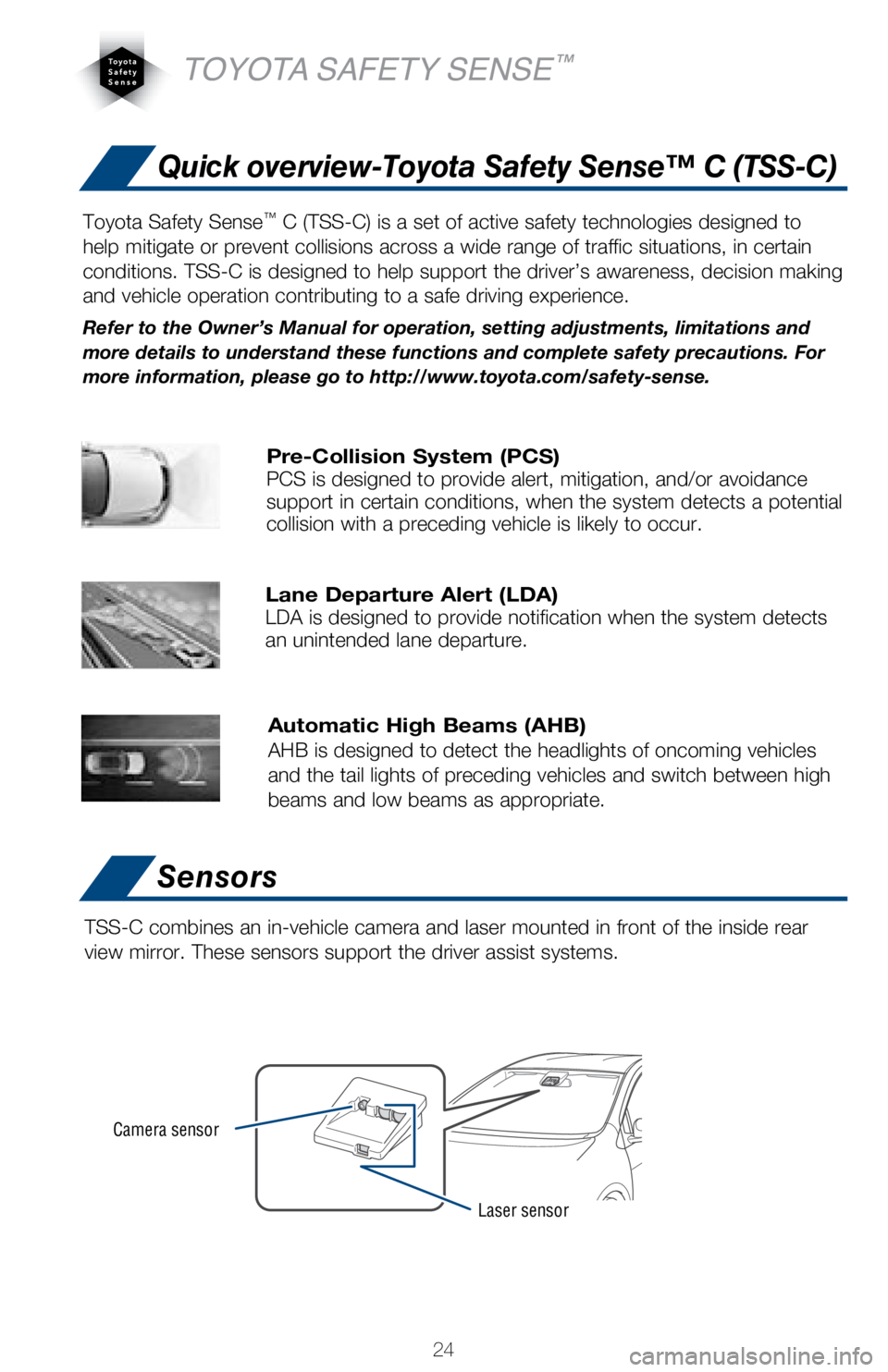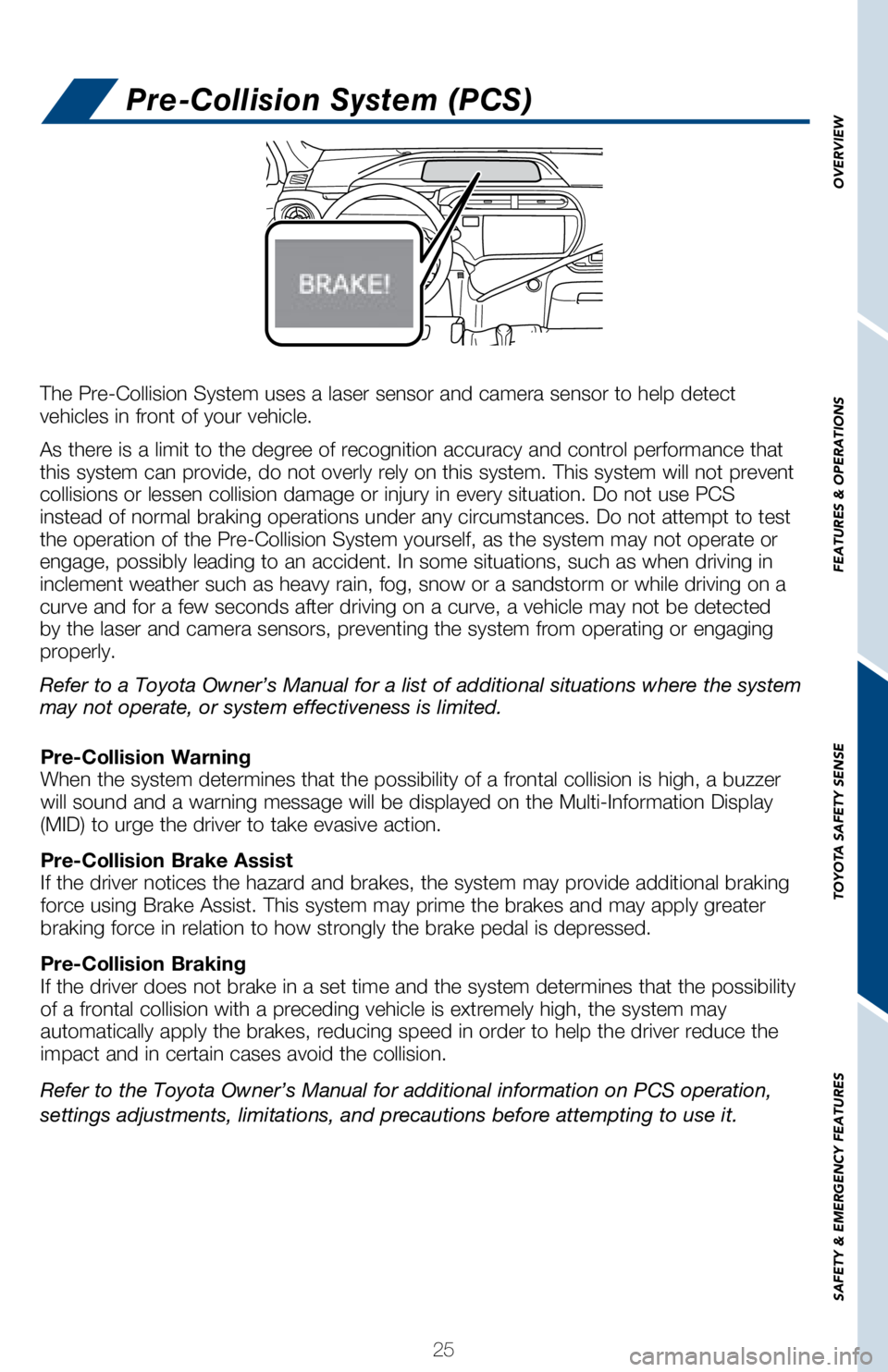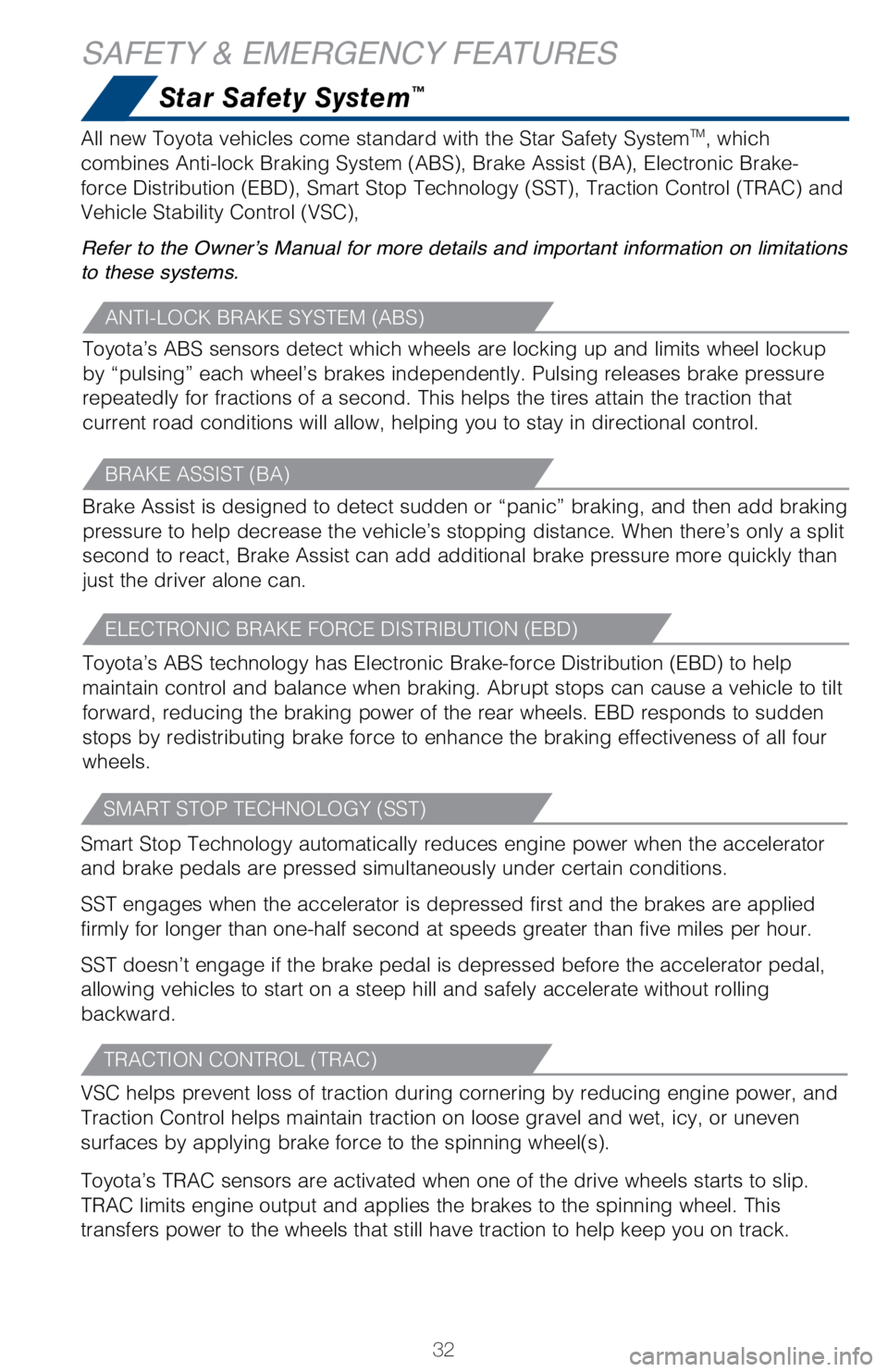sensor TOYOTA PRIUS C 2018 Owners Manual (in English)
[x] Cancel search | Manufacturer: TOYOTA, Model Year: 2018, Model line: PRIUS C, Model: TOYOTA PRIUS C 2018Pages: 48, PDF Size: 1.92 MB
Page 3 of 48

1
INDEX
Engine maintenance 9
Fuel tank door release & cap
7
Hood release
8
Indicator symbols
4-5
Instrument cluster
4
Instrument panel
2-3
Instrument panel light control
8
Keyless entry1,2 6
Smart Key system1,2 7
1 Visit your Toyota dealer for information on customizing this feature.2 Programmable by customer. Refer to the Owner’s Manual for instructio\
ns and more information.
OVERVIEW
FEATURES & OPERATIONS SAFETY & EMERGENCY FEATURES
Audio 18
Auto lock/unlock1,2 17
Automatic air conditioning/heating
16
Clock
22
Cruise control
20
Drive mode
11
Hill-start Assist Control (HAC)
23
Hybrid Synergy Drive System
10
Hybrid transmission
11
Lights1,2 & turn signals 15
Moonroof
17
Multi-Information Display (MID)1 21
Parking brake
20
Power outlet-12V DC
18
Rear view monitor system
23
Seat adjustments-Front
12
Seat-Folding down rear seat
13
Seat heaters
16
Seats-Head restraints
12
Steering wheel switches
19
Telephone controls (Bluetooth®) 22
Tilt & telescopic steering wheel
21
Vehicle Stability Control (VSC)/
TRAC OFF switch
23
USB/AUX port
19
Windows-Power
13
Windshield wipers & washers
14 Door locks
31
Floor mat installation
33
Rear door child safety locks
31
Seat belts
30
Spare tire & tools
31
Star Safety System™
32-33
Tire Pressure Monitoring
(warning) System (TPMS)
30
BLUETOOTH® DEVICE
PAIRING SECTION 34-43
TOYOTA SAFETY SENSE™ C (TSS-C)
Automatic High Beams (AHB) 29
Lane Departure Alert (LDA)
27-28
Pre-Collision System (PCS)
25-26
Quick overview-
Toyota Safety Sense™ C (TSS-C)
24
Sensors
24
OVERVIEW
FEATURES & OPERATIONS
TOYOTA SAFETY SENSE
SAFETY & EMERGENCY FEATURES
Page 26 of 48

24
Pre-Collision System (PCS)PCS is designed to provide alert, mitigation, and/or avoidance
support in certain conditions, when the system detects a potential
collision with a preceding vehicle is likely to occur.
Lane Departure Alert (LDA)LDA is designed to provide notification when the system detects
an unintended lane departure.
Automatic High Beams (AHB)
AHB is designed to detect the headlights of oncoming vehicles
and the tail lights of preceding vehicles and switch between high
beams and low beams as appropriate.
Laser sensor
Camera sensor
Quick overview-Toyota Safety Sense™ C (TSS-C)
Sensors
TOYOTA SAFETY SENSE™
Toyota Safety Sense™ C (TSS-C) is a set of active safety technologies designed to
help mitigate or prevent collisions across a wide range of traffic situa\
tions, in certain
conditions. TSS-C is designed to help support the driver’s awareness,\
decision making
and vehicle operation contributing to a safe driving experience.
Refer to the Owner’s Manual for operation, setting adjustments, limit\
ations and
more details to understand these functions and complete safety precautio\
ns. For
more information, please go to http://www.toyota.com/safety-sense.
TSS-C combines an in-vehicle camera and laser mounted in front of the in\
side rear
view mirror. These sensors support the driver assist systems.
Page 27 of 48

25
OVERVIEW
FEATURES & OPERATIONS
TOYOTA SAFETY SENSE
SAFETY & EMERGENCY FEATURES
Pre-Collision System (PCS)
The Pre-Collision System uses a laser sensor and camera sensor to help d\
etect
vehicles in front of your vehicle.
As there is a limit to the degree of recognition accuracy and control pe\
rformance that
this system can provide, do not overly rely on this system. This system \
will not prevent
collisions or lessen collision damage or injury in every situation. Do n\
ot use PCS
instead of normal braking operations under any circumstances. Do not att\
empt to test
the operation of the Pre-Collision System yourself, as the system may no\
t operate or
engage, possibly leading to an accident. In some situations, such as whe\
n driving in
inclement weather such as heavy rain, fog, snow or a sandstorm or while \
driving on a
curve and for a few seconds after driving on a curve, a vehicle may not \
be detected
by the laser and camera sensors, preventing the system from operating or\
engaging
properly.
Refer to a Toyota Owner’s Manual for a list of additional situations \
where the system
may not operate, or system effectiveness is limited.
Refer to the Toyota Owner’s Manual for additional information on PCS \
operation,
settings adjustments, limitations, and precautions before attempting to \
use it. Pre-Collision Warning
When the system determines that the possibility of a frontal collision i\
s high, a buzzer
will sound and a warning message will be displayed on the Multi-Informat\
ion Display
(MID) to urge the driver to take evasive action.
Pre-Collision Brake Assist
If the driver notices the hazard and brakes, the system may provide addi\
tional braking
force using Brake Assist. This system may prime the brakes and may apply\
greater
braking force in relation to how strongly the brake pedal is depressed.
Pre-Collision Braking
If the driver does not brake in a set time and the system determines tha\
t the possibility
of a frontal collision with a preceding vehicle is extremely high, the s\
ystem may
automatically apply the brakes, reducing speed in order to help the driv\
er reduce the
impact and in certain cases avoid the collision.
Page 34 of 48

32
SAFETY & EMERGENCY FEATURES
Star Safety System™
ANTI-LOCK BRAKE SYSTEM (ABS)
Toyota’s ABS sensors detect which wheels are locking up and limits wh\
eel lockup
by “pulsing” each wheel’s brakes independently. Pulsing release\
s brake pressure
repeatedly for fractions of a second. This helps the tires attain the tr\
action that
current road conditions will allow, helping you to stay in directional c\
ontrol.
BRAKE ASSIST (BA)
Brake Assist is designed to detect sudden or “panic” braking, and \
then add braking
pressure to help decrease the vehicle’s stopping distance. When there\
’s only a split
second to react, Brake Assist can add additional brake pressure more qui\
ckly than
just the driver alone can.
TRACTION CONTROL (TRAC)
VSC helps prevent loss of traction during cornering by reducing engine p\
ower, and
Traction Control helps maintain traction on loose gravel and wet, icy, o\
r uneven
surfaces by applying brake force to the spinning wheel(s).
Toyota’s TRAC sensors are activated when one of the drive wheels star\
ts to slip.
TRAC limits engine output and applies the brakes to the spinning wheel. \
This
transfers power to the wheels that still have traction to help keep you \
on track.
ELECTRONIC BRAKE FORCE DISTRIBUTION (EBD)
Toyota’s ABS technology has Electronic Brake-force Distribution (EBD\
) to help
maintain control and balance when braking. Abrupt stops can cause a vehi\
cle to tilt
forward, reducing the braking power of the rear wheels. EBD responds to \
sudden
stops by redistributing brake force to enhance the braking effectiveness\
of all four
wheels.
All new Toyota vehicles come standard with the Star Safety System
TM, which
combines Anti-lock Braking System (ABS), Brake Assist (BA), Electron\
ic Brake-
force Distribution (EBD), Smart Stop Technology (SST), Traction Cont\
rol (TRAC) and
Vehicle Stability Control (VSC),
Refer to the Owner’s Manual for more details and important information on limitations
to these systems.
SMART STOP TECHNOLOGY (SST)
Smart Stop Technology automatically reduces engine power when the accele\
rator
and brake pedals are pressed simultaneously under certain conditions.
SST engages when the accelerator is depressed first and the brakes are a\
pplied
firmly for longer than one-half second at speeds greater than five miles\
per hour.
SST doesn’t engage if the brake pedal is depressed before the acceler\
ator pedal,
allowing vehicles to start on a steep hill and safely accelerate without\
rolling
backward.